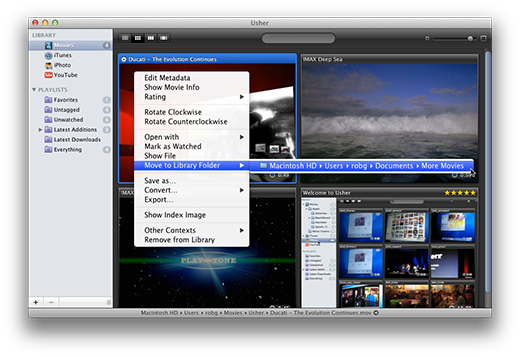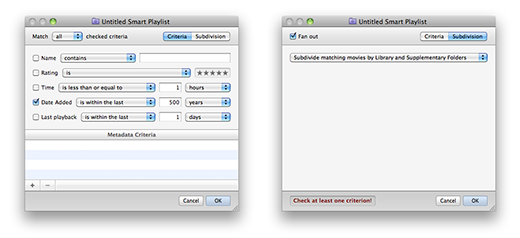Usher is our powerful movie management tool; its mission in life is to bring order to the chaos that can be one’s collection of videos. To help you get the most out of Usher, this how-to covers setting up Usher’s main Library folder, adding more storage space, and moving movie files to a new hard drive (replacing an existing smaller drive).
Basic Library folder setup
Our recommended setup for Usher is to create your main Library folder on your machine’s boot disk, regardless of whether you intend to keep any movies there or not. By having the main Library folder on your boot drive, you’ll be able to see all your movies, even if they’re stored on a not-currently-connected external drive; you can even edit those movies’ metadata without them being physically present.
(If you’ve got a machine with more than one hard drive, and the extra drive (or drives) is always connected, feel free to place your Library folder on that drive. It’s only drives that are transient in nature that can be problematic as Library folder locations.)
If you simply install Usher and run it, this is the setup you will get—the main Library folder is created in your user’s Movies folder, within an Usher folder we create there. While you don’t have to use this arrangement, we strongly recommend that the main Library folder reside somewhere on your boot drive, or other always-there drive. (You can choose a new location for the Library folder on the Library tab of Usher’s preferences panel.)
After you’ve used Usher for a while, assuming you’re actively growing your movie collection, there’s a good chance you’ll find yourself running short on drive space. Thankfully, Usher makes it really easy to add additional storage space to your collection.
Add more storage space
Usher uses something called Supplementary Folders to help you easily and infinitely expand your library. Let’s say you’ve been keeping your collection on your MacBook Pro’s boot disk, but it’s filling up, and so you’d like to add an external 1TB FireWire drive to the mix. After buying the drive and getting it set up, adding this new storage space to Usher is a very simple process:
- Create a new folder on the external drive; call it whatever you like, but something that reminds you that it holds Usher movies might serve as a nice memory minder in the future.
- Open Usher’s Preferences, and go to the Library tab. Click on the Supplementary… button, then select Add Supplementary Folder… from the menu that appears.
- In the dialog that appears, navigate to and select the folder you created in step one.
And that’s that—almost. You probably also want to enable this setting, also on the Library tab of Usher’s Preferences.

Now when you drop movies into that folder in Finder, Usher will sense them and automatically add them to your library. (You could leave the pop-up portion on ‘report’ if you don’t want Usher to automatically add all new files to the library.)
Move movies to newly-added space
Once you’ve got your additional space created, you may want to reorganize your library, moving movies from (in this example) the internal hard drive to the newly-added external hard drive. You may be tempted to do this in Finder, but please don’t!
Do not use Finder to move your movies! Let Usher do the work, so that all file references can be properly updated. If you use Finder, Bad Things™ may result.
To let Usher do the work, Control-click on any movie (use Shift-click and/or drag to select multiple movies, then Control-click on one) and select Move to Library Folder from the pop-up menu; this will slide out a sub-menu, listing all the available Library folders. Choose the one you want, and the selected movie(s) will be moved to that folder.
This process can take a while, especially if you move a ton of huge movies. In such cases, letting the move operation run overnight isn’t a bad idea.
Keep track of your movies
Once you’ve added one (or more) Supplementary folders, you may find it hard to remember which movies are stored in which Library (as Usher presents everything as one large combined library). You can solve this problem using a special Smart Playlist that will show your movies organized into subfolders, based on where they’re physically stored:

As seen in the screenshot, this special Smart Playlist shows you exactly where your movies reside; select one of the listed folders, and you’ll only see the movies that are presently located on that drive. This makes it very easy to find the movies you wish to move between Library folders.
To create this Smart Playlist, select File > New Smart Playlist. On the Criteria tab of the new window that opens, enter some criteria that will be true for 100% of your movies. In this example, I’ve used Date Added is within the last 500 years, which should cover even the oldest clips in my collection.
Next, click on the Subdivision tab, and set the pop-up to ‘Subdivide matching movies by Library and Supplementary Folders.’ You can check Fan Out if you wish; if enabled, selecting the Smart Playlist folder (“Movie Locations” in my example) will show you the contents of all subfolders. When done, the two Smart Playlist setup screens should look something like this:
Click OK, and your Smart Playlist will be created, showing movies in your Library and Supplementary folders, as well as those stored in iTunes, iPhoto, and Aperture.
Replace an external drive
Building off my previous example, assume more time has passed, and the previously-huge 1TB drive is now nearly full. You’ve got your eyes on a new 4TB external, but you don’t have the desk space required for two external drives. (If you’ve got the space, you don’t need to do what we’re about to discuss; you can just plug in the new drive and add another Supplementary folder, as detailed above.)
If you want to replace a drive that’s being used as a Supplementary folder in Usher, there are two ways to do it: neither is particularly hard, and both will take some time.
Scenario One: You name your new external drive exactly the same as the existing external drive.
If this is the case, your drive migration is greatly simplified. Quit Usher, then install and use SuperDuper or Carbon Copy Cloner. These apps allow you to clone (create an exact copy of) one drive onto another drive. Clone the old 1TB drive onto the new 4TB drive, then disconnect the old drive, leaving the new one connected. Launch Usher, and everything should just work: You’ll have all your movies, in their same locations, but with storage space to burn (or should that be rip?).
Note that you can also use Apple’s Disk Utility to do this, via its Restore feature. Read the section on Disk Utility (near the top) in Macworld’s More ways to move data to a new Mac article for details on that method.
Scenario Two: You want to give the new external drive a different name than the existing drive.
This is the more-complicated scenario, though it’s still not too difficult. First, create a new folder on the 4TB drive, and add it as another Supplementary folder within Usher. Using the Smart Playlist you created in the previous section, select all the movies that are in the old Supplementary folder, Control-click on them, and select Move to Library Folder from the pop-up menu.
You should see your newly-added folder as one of the available destinations; select it, then…watch a movie or read a book or take a little trip, because (assuming you really do have 1TB of movies) this step is going to take a while. A long while, in case the preceding links didn’t make that completely obvious. Don’t panic, though, the massive migration will eventually finish.
Once the process finishes, select Library > Library Folder > Usher > [name of old Supplementary folder] > Remove. (Note that “Usher” will be whatever you named your primary Library folder.) This will remove the now-empty old Supplementary folder, leaving you with the main Library folder, and the new Supplementary folder on the new 4TB drive.
Wrap up
Usher’s ability to infinitely expand your library is one of its strongest features; never again need you fear running out of space for your library. If, however, you can’t just add new drives to your machine due to space or technical restraints, you can use the “replace an external drive” section of this guide to migrate your collection to a new, larger drive.
 Many Tricks
Many Tricks



